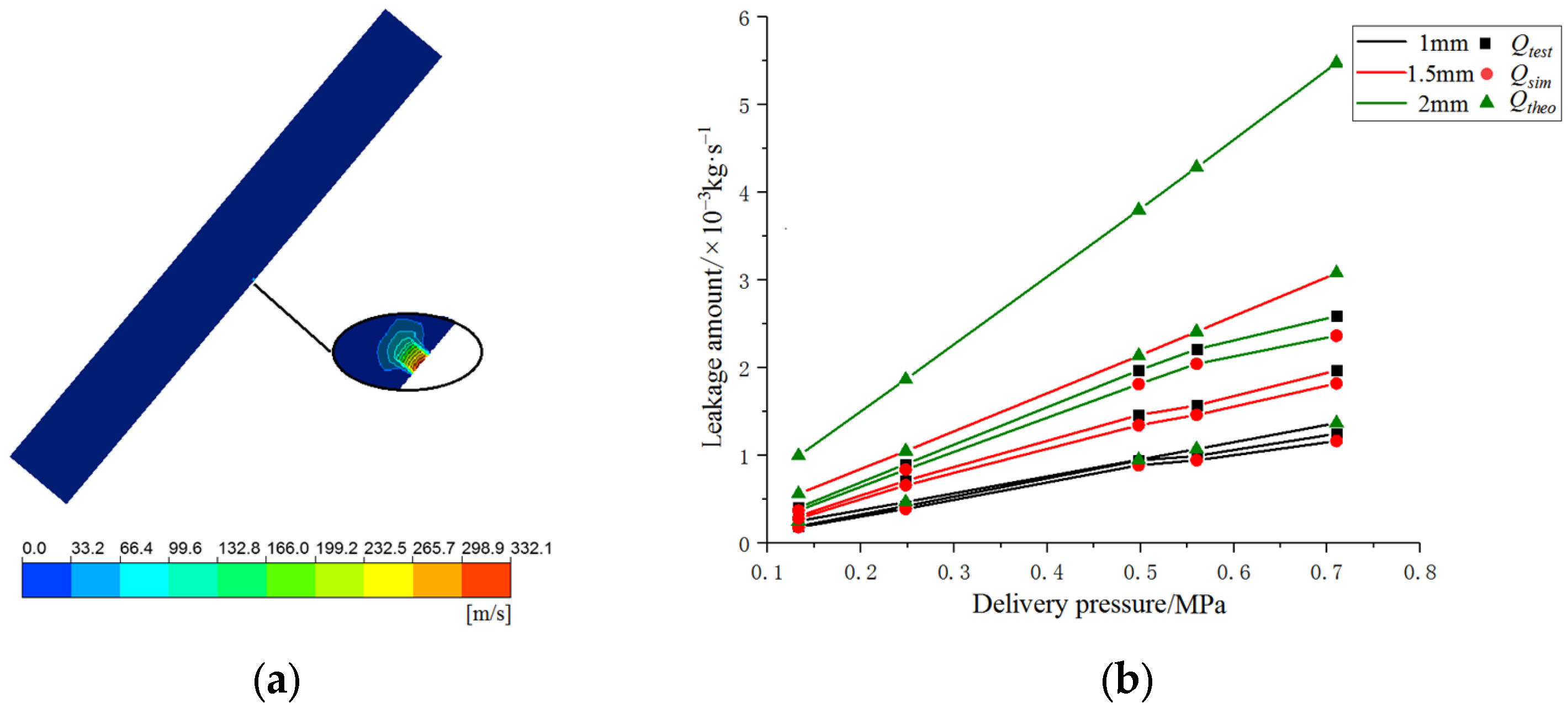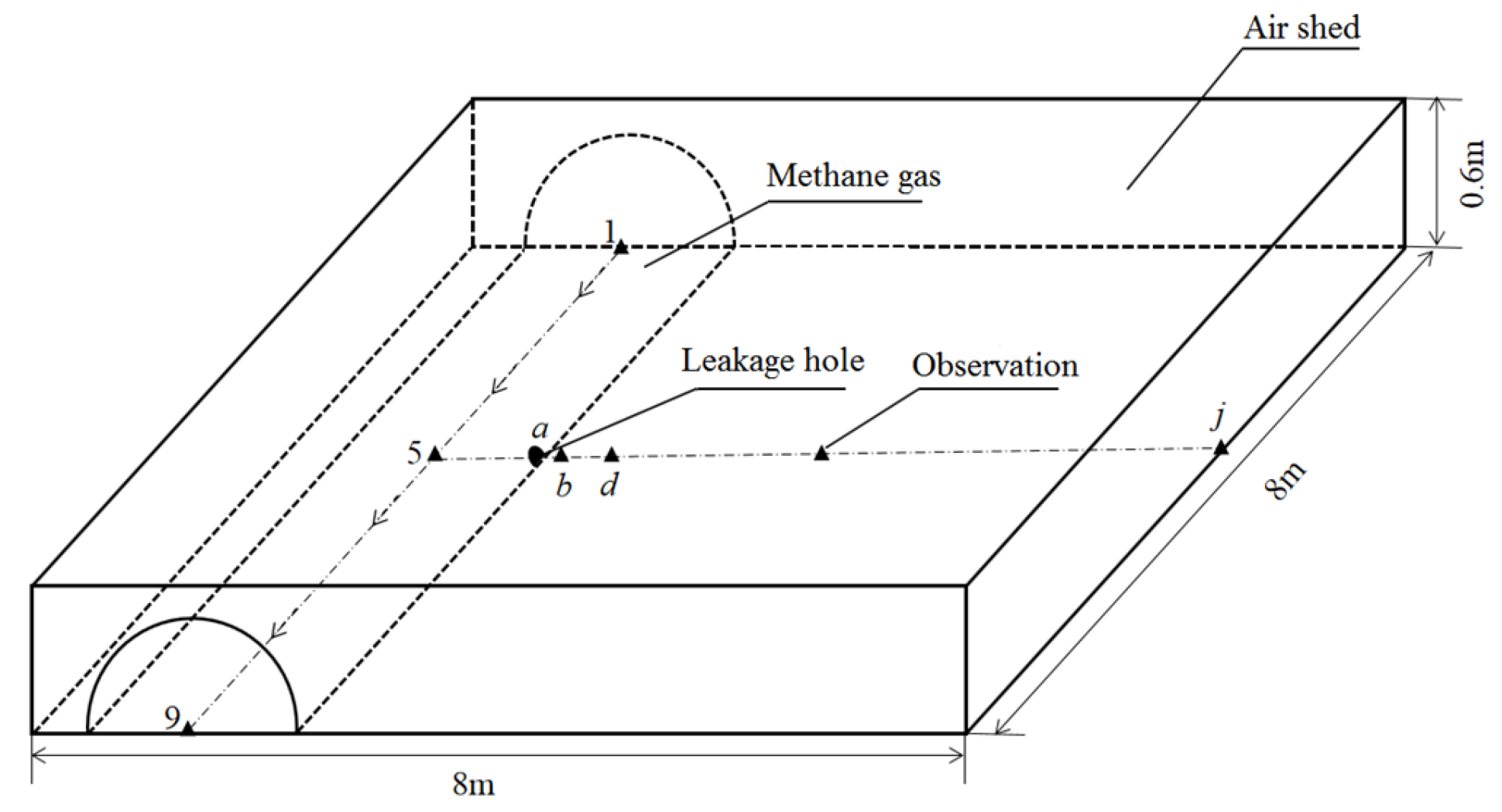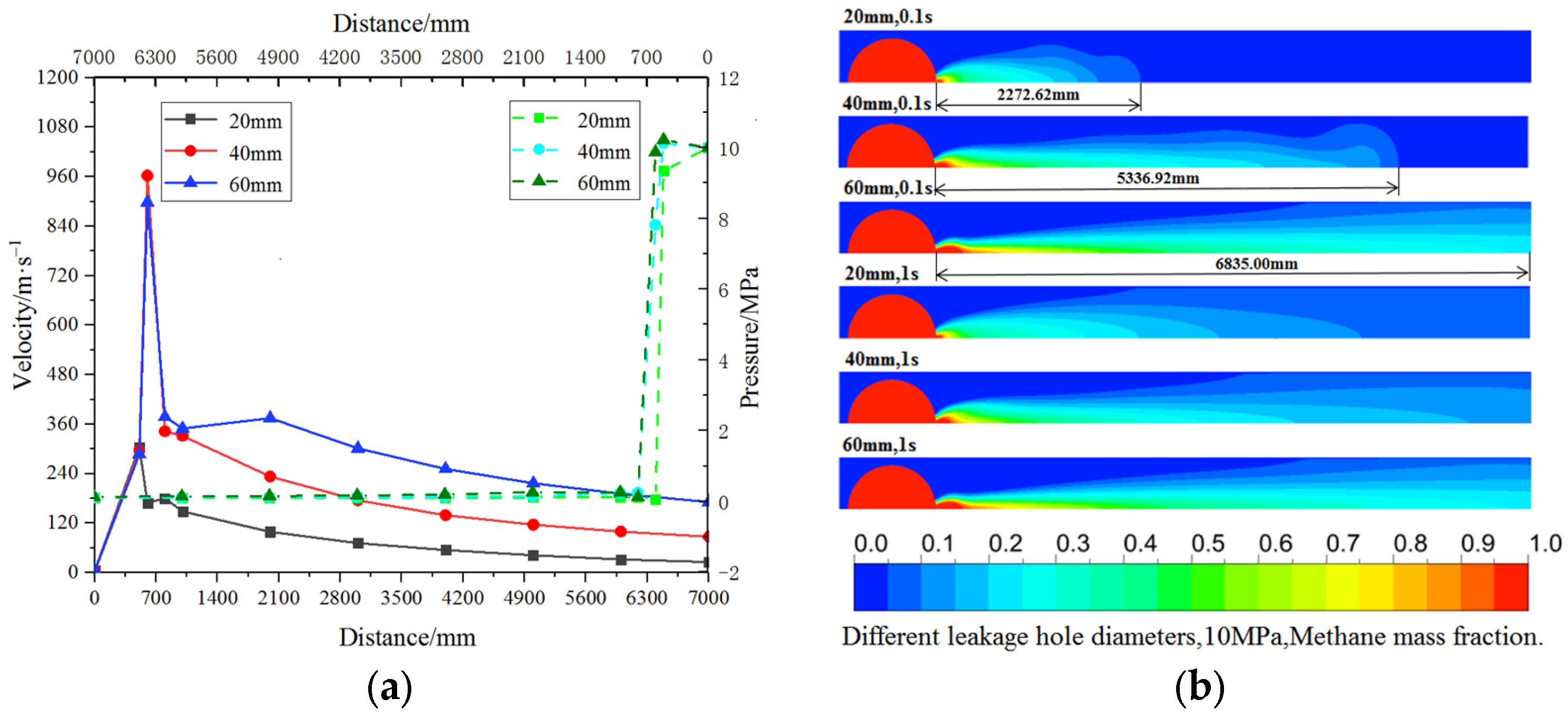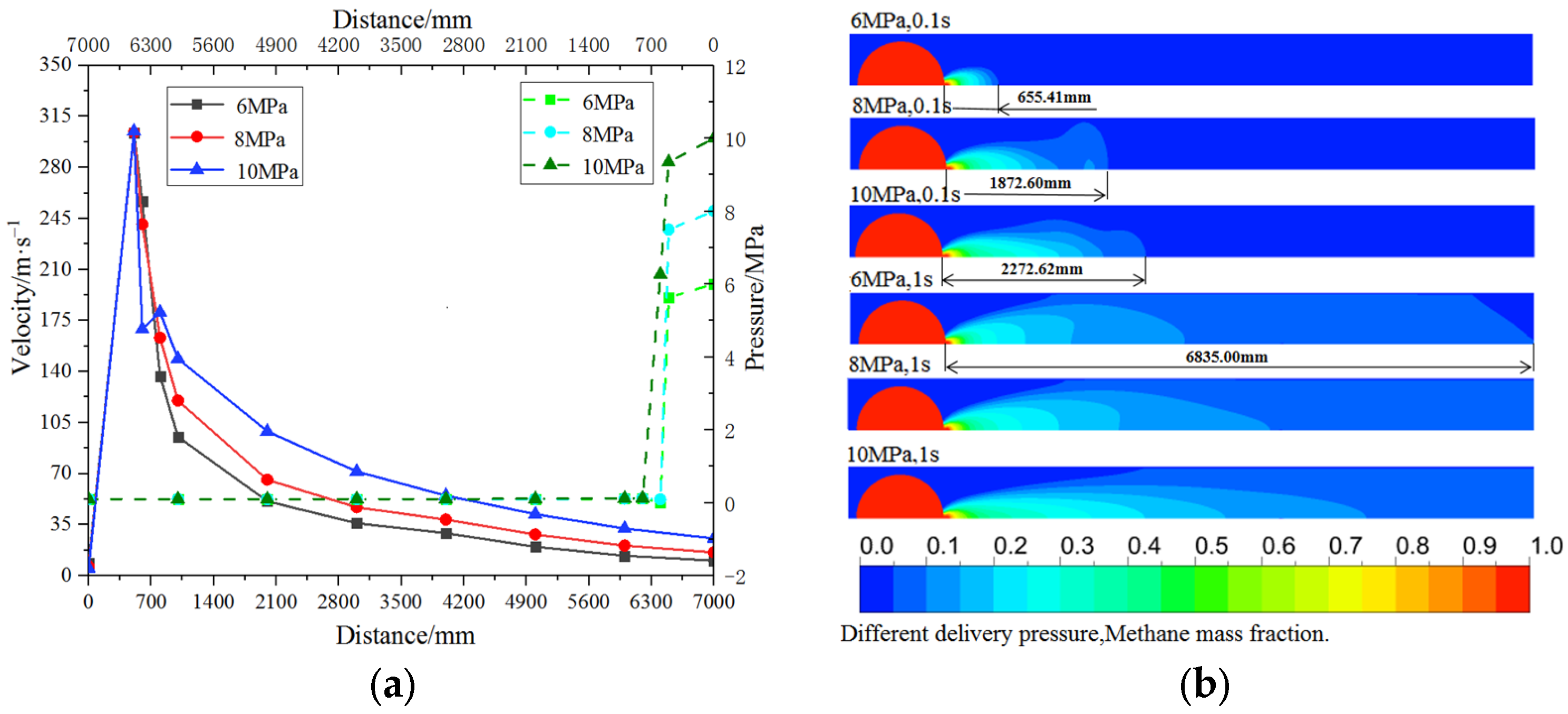Research on Pipeline Leakage Calculation and Correction Method Based on Numerical Calculation Method
Abstract
:1. Introduction
2. Theoretical and Simulation Calculations
2.1. Theoretical Calculation of Pipeline Gas Leakage Based on Hole Model
2.1.1. Theoretical Analysis of Pipeline Leakage under Different Leakage Aperture Ratios
- ①
- When the temperature of the gas inside and outside the pipeline is similar, the flow of the gas inside the pipe is regarded as adiabatic flow;
- ②
- In the leak hole of the pipeline, due to the gas leakage velocity being larger, the flow is regarded as isentropic flow;
- ③
- External work performed in the process of the leakage of the gas, as well as friction loss, is ignored.
- (1)
- Analysis of the impact of pipeline transport pressure
- ①
- When pk > pic, the flow state at the leak hole is critical flow, the pressure at the center of the leak hole is equal to the critical pressure, and the gas leakage per unit time is:
- ②
- When pk ≤ pic, the flow state at the leak hole is subcritical, leak hole center pressure is equal to atmospheric pressure, and gas leakage per unit of time is calculated using Equation (2).
- (2)
- Analysis of the impact of pipeline leakage aperture ratio
- ①
- When d0/D ≤ 0.2, it is defined as small-hole leakage model. As the leakage aperture is small, the pressure inside the tube is less affected by the leakage, and the gas leakage rate is constant; at this time, pk = pi; when pi > pic, the gas flow inside and outside the leak hole is at critical flow, using Equation (4) to calculate the gas leakage rate; when pi ≤ pic, the gas flow inside and outside the leak hole is subcritical flow, using Equation (2) to calculate the gas leakage rate.
- ②
- When 0.2 ≤ d0/D < 1, it is defined as a large-hole leakage model. When the leakage aperture is relatively small, pk is slightly reduced by the leakage pressure; at this time, pic ≪ pk < pi, the gas flow inside the pipe is subcritical flow, and the gas flow at the leak hole is at critical flow; the gas leakage rate is calculated using Equation (4); with the increase of the leakage aperture, the pk is affected by the leakage and is reduced drastically; at this time, pk ≪ pi and pk < pic, the gas flow inside and outside the leak hole is at subcritical flow, using Equation (2) to calculate the gas leakage rate.
- ③
- When d0/D = 1, which is the pipeline cross-section fracture, defined as a broken pipe leakage model, the leakage rate is equal to the mass flow rate of the pipeline cross-section per unit time.
2.1.2. Calculation of Pipeline Leakage Based on Theoretical Calculation Methods
2.2. Calculation of Pipeline Gas Leakage Based on Numerical Calculation Methods
2.2.1. Establishment of Pipeline Leakage Model Considering Three-Dimensional Structure
2.2.2. Comparative Analysis of Pipeline Leakage
2.2.3. Simulation of Small-Hole Leakage in High-Pressure Pipelines
3. Results and Discussion
3.1. Analysis of Leakage Dispersion in High-Pressure Gas Pipelines under Different Influencing Agents
3.1.1. The Influence of Leakage Aperture on the Diffusion of Leakage in High-Pressure Gas Pipeline
3.1.2. The Influence of Leak Hole Shape on Leakage Diffusion in High-Pressure Gas Pipeline
3.1.3. Influence of Delivery Pressure on the Spread of Leaks in High-Pressure Gas Pipelines
3.2. Correction of Pipeline Small Hole Leakage Calculation Based on Numerical Calculation Method
3.2.1. Correction of the Influence Coefficient of Pipeline Leakage Pressure
- (1)
- The theoretical formula for calculating the leakage rate of the pipeline is only applicable in cases where the gas pressure inside the pipeline is constant during the leakage process, and when the leakage of the pipeline causes the pressure inside the pipeline to change, the calculation accuracy of the model is reduced.
- (2)
- The theoretical calculation model is based on assumptions, such as that the gas in the pipe is regarded as an incompressible ideal gas, and the gas flow process in the pipe is regarded as an adiabatic flow, which is inconsistent with the leakage process in an actual situation.
3.2.2. Correction of the Influence Coefficient of Pipeline Leak Hole Shape
3.2.3. Correction of the Coefficient of Influence of the Diameter of the Leak Hole of the Pipeline
- ①
- pi > pic.
- ②
- d0/D ≤ 0.2 (when leak holes are rectangular or diamond-shaped, calculate equivalent round hole diameter by area.)
- ③
- Select the corresponding hole flow coefficient according to the shape of the leak hole.
- ④
- The formula applies only to the leakage of gas from the pipe into the atmosphere; the leakage of buried pipelines or pipelines under other laying conditions should be analyzed separately.
4. Conclusions
- (1)
- Considering the complex flow process of gas in the pipeline and the influence of the gas interaction between inside and outside the pipeline on the leakage of the pipeline, a three-dimensional leakage diffusion model coupling the pipeline and the air domain was established based on the component transport model and the selection of methane–air mixture components, and the leakage of the experimental pipeline was simulated and analyzed under different influencing factors, which resulted in the relative error range of the experimental leakage and the simulated leakage from −5.03% to −8.65%, which verifies the accuracy of the numerical calculation model of this paper.
- (2)
- Comparative analysis of the leakage diffusion process of high-pressure pipelines under different influencing factors shows that when the hole diameter increases from 20 mm to 60 mm, the gas leakage velocity at the center of the leak hole decreases by 16.81 m/s, and the leakage volume increases by 42.259 kg/s−1. For leak holes in the same area, the order of leakage is rectangle > diamond > circle; compared with circular leak holes, the shapes of gas leakage velocity distribution of rectangular and diamond leak holes are more regular, and the range of leakage velocity distribution is larger. With the increase in delivery pressure, the amount of gas leakage gradually increases; when the conveying pressure increased from 6 MPa to 10 MPa, the leakage 0.1 s gas injection distance increased by 1617.21 mm.
- (3)
- Using the least squares method to linearly fit the error between the simulated leakage and the theoretical leakage, the correction coefficients for the delivery pressure, the shape of the leak hole, and the diameter of the leak hole were solved, and the corrected leakage formula was obtained. The theoretical leakage calculated by the corrected formula was closer to the simulated leakage, and the relative error range between the two was reduced from −8.40%~18.03% before correction to −1.58%~2.60%, which significantly improves accuracy.
Author Contributions
Funding
Data Availability Statement
Conflicts of Interest
References
- Hou, Z.M.; Luo, J.S.; Cao, C.; Ding, G.S. Development and contribution of natural gas industry under China’s carbon neutrality target. Eng. Sci. Technol. 2023, 55, 243–252. (In Chinese) [Google Scholar]
- Li, J.; She, Y.G.; Gao, Y.; Li, M.P.; Yang, G.I.; Shi, Y.J. Natural gas industry in China: Development situation and prospect. Nat. Gas. Ind. 2020, 7, 604–613. [Google Scholar] [CrossRef]
- Zhu, Z.; Liao, Q.; Qiu, R.; Liang, Y.T.; Song, Y.; Xue, S. Technical and economic analysis of long-distance hydrogen pipeline transportation. Petrol. Sci. Bull. 2023, 1, 112–124. (In Chinese) [Google Scholar]
- He, D.B.; Jia, C.G.; Wei, Y.S.; Guo, J.L.; Ji, G.; Li, Y.L. World natural gas industry situation and development trend. Nat. Gas. Ind. 2022, 42, 1–12. (In Chinese) [Google Scholar]
- Ding, Y.Q.; Zhou, H.Y.; Lu, Y.; Cheng, J.H.; Ye, B.T.; Li, W.W.; Ma, Q.R. Study on the influence of dynamic response of buried pipeline explosion based on multiphase coupling. Chem. Mach. 2019, 46, 425–432. (In Chinese) [Google Scholar]
- Levenspiel, O. Engineering Flow and Heat Exchange; Plenum Press: New York, NY, USA, 1984. [Google Scholar]
- Crowl, D.A. Chemical Process Safety: Fundamentals with Application; Prentice-Hall: Upper Saddle River, NJ, USA, 1990. [Google Scholar]
- Woodward, J.L.; Mudan, K.S. Liquid and gas discharge rates through holes in process vessels. J. Loss Prev. Process Ind. 1991, 4, 161–165. [Google Scholar] [CrossRef]
- Montiel, H.; Vilchez, J.A.; Casal, J.; Arnaldos, J. Mathematical modeling of accidental gas release. J. Hazard. Mater. 1998, 59, 211–233. [Google Scholar] [CrossRef]
- Xiang, S.P.; Feng, L.; Zhou, Y.C. Leakage model of natural gas pipeline. Nat. Gas. Ind. 2007, 27, 100–102. (In Chinese) [Google Scholar]
- Wang, Z.Q.; Feng, W.X.; Li, Z.R.; Xiang, X.Q.; Li, B.J.; Cheng, W.Y. High Pressure Gas Pipeline Leakage Model. Oil Gas. Storage Transp. 2009, 28, 28–30. (In Chinese) [Google Scholar]
- Zhang, P.; Zhou, L.; Lu, C.; He, L.; Wang, X.L.; Zhao, H. GERG-2008 equation was used to calculate natural gas compression factor and hydrocarbon dew point. Nat. Gas. Ind. 2021, 41, 134–143. (In Chinese) [Google Scholar]
- Chen, Q.; Xing, X.K.; Jin, C.; Zuo, L.L.; Wu, J.H.; Wang, W.S. A novel method for transient leakage flow rate calculation of gas transmission pipelines. J. Nat. Gas. Sci. Eng. 2022, 77, 103261. [Google Scholar] [CrossRef]
- Hou, Q.M.; Yang, D.H.; Li, X.Y.; Xiao, G.H.; Ho, S.C.M. Modified Leakage Rate Calculation Models of Natural Gas Pipelines. Math. Probl. Eng. 2020, 2020, 6673107. [Google Scholar] [CrossRef]
- Sun, J.F. Research on Natural Gas Pipeline Leakage Process Simulation and Leakage Calculation. Master’s Thesis, China University of Petroleum, Beijing, China, 2020; pp. 15–20. (In Chinese). [Google Scholar]
- Hu, H.B. Analysis of the current situation of natural gas pipeline leakage research. Contemp. Chem. Ind. 2016, 45, 352–354. (In Chinese) [Google Scholar]
- Tauseef, S.M.; Rashtchian, D.; Abbasi, S.A. CFD-based simulation of dense gas dispersion in presence of obstacles. J. Loss Prev. Process Ind. 2011, 24, 371–376. [Google Scholar] [CrossRef]
- Ma, J.; Liu, H.S.; Liu, L.; Xie, M. Simulation study on the cryogenic liquid nitrogen jets: Effects of equations of state and turbulence models. Cryogenics 2021, 117, 103330. [Google Scholar] [CrossRef]
- Amir, E.M.; Mahmood, F.J.; Ahmad, A.; Ali, J.M. CFD analysis of natural gas emission from damaged pipelines: Correlation development for leakage estimation. J. Clean. Prod. 2018, 199, 257–271. [Google Scholar]
- Gao, B.; Zhao, R.T.; Kuai, C.T.; Hu, M.Y.; Wang, G.F. Numerical simulation study on leakage diffusion and failure consequences of high pressure hydrogen-doped natural gas pipeline. J. Liaoning. Univ. Petrochem. Technol. 2023, 43, 60–67. (In Chinese) [Google Scholar]
- Liu, C.W.; Liao, Y.H.; Liang, J.; Cui, Z.X.; Li, Y.X. Quantifying methane release and dispersion estimations for buried natural gas pipeline leakages. Process. Saf. Environ. Prot. 2021, 146, 552–563. [Google Scholar] [CrossRef]
- Javad, B.; Esmaeil, F.; Ali, R. CFD investigation of natural gas leakage and propagation from buried pipeline for anisotropic and partially saturated multilayer soil. J. Clean. Prod. 2020, 277, 123940. [Google Scholar]
- Li, X.H.; Chen, G.M.; Zhang, R.Z.; Zhu, H.W.; Fu, J.M. Simulation and assessment of underwater gas release and dispersion from subsea gas pipelines leak. Process. Saf. Environ. Prot. 2018, 119, 46–57. [Google Scholar]
- Shi, Y.D.; Ge, T.M.; Zhang, Z.F. Study on gas leakage and diffusion simulation and influencing factors of submarine gas pipeline. Chem. Eng. Oil Gas. 2020, 49, 109–115. (In Chinese) [Google Scholar]
- Duan, C.G. Gas Transmission and Distribution; China Construction Industry Press: Beijing, China, 2001. (In Chinese) [Google Scholar]
- Cong, Z.W.; Ma, T.X.; Yu, D.L.; Wu, D.R. Characterization of natural gas pipeline leak diffusion in foothill terrain. J. Saf. Environ. 2022, 22, 2078–2085. (In Chinese) [Google Scholar]
- Wang, C.P. Study on Leakage Simulation and Risk Control Measures of Long-Distance Natural Gas Pipeline. Master’s Thesis, China University of Petroleum, Beijing, China, 2014; pp. 17–19. (In Chinese). [Google Scholar]
- Teng, Z.C. Finite Element Simulation of Saint-Venant’s Principle. Value Eng. 2018, 37, 188–190. (In Chinese) [Google Scholar]









| Delivery Pressure (MPa) | 1 mm Aperture | 1.5 mm Aperture | 2 mm Aperture | ||||||
|---|---|---|---|---|---|---|---|---|---|
| Qtest | Qtheo | Relative Error | Qtest | Qtheo | Relative Error | Qtest | Qtheo | Relative Error | |
| 0.710 | 1.248 | 1.369 | 9.70% | 1.970 | 3.081 | 56.40% | 2.590 | 5.478 | 111.51% |
| 0.560 | 0.994 | 1.072 | 7.85% | 1.570 | 2.411 | 53.57% | 2.211 | 4.287 | 93.89% |
| 0.498 | 0.943 | 0.950 | 0.74% | 1.460 | 2.137 | 46.37% | 1.970 | 3.800 | 92.89% |
| 0.248 | 0.421 | 0.467 | 10.93% | 0.711 | 1.050 | 47.68% | 0.900 | 1.867 | 107.44% |
| 0.133 | 0.192 | 0.249 | 29.69% | 0.305 | 0.560 | 83.61% | 0.404 | 0.995 | 146.29% |
| Delivery Pressure (MPa) | 1 mm Aperture | 1.5 mm Aperture | 2 mm Aperture | ||||||
|---|---|---|---|---|---|---|---|---|---|
| Qtest | Qtheo | Relative Error | Qtest | Qtheo | Relative Error | Qtest | Qtheo | Relative Error | |
| 0.710 | 1.248 | 1.164 | −6.73% | 1.970 | 1.821 | −7.56% | 2.590 | 2.366 | −8.65% |
| 0.560 | 0.994 | 0.944 | −5.03% | 1.570 | 1.463 | −6.82% | 2.211 | 2.044 | −7.55% |
| 0.498 | 0.943 | 0.886 | −6.04% | 1.460 | 1.344 | −7.95% | 1.970 | 1.814 | −7.92% |
| 0.248 | 0.421 | 0.389 | −7.60% | 0.711 | 0.659 | −7.31% | 0.900 | 0.837 | −7.00% |
| 0.133 | 0.192 | 0.180 | −6.25% | 0.305 | 0.279 | −8.52% | 0.404 | 0.370 | −8.42% |
| Leak Hole Diameter (mm) | Simulated Leakage Rate (kg·s−1) | Leak Hole Center Velocity (m·s−1) | Leak Hole Center Pressure (MPa) |
|---|---|---|---|
| 20 | 6.2654 | 304.71 | 9.3448 |
| 40 | 22.6718 | 296.50 | 10.1317 |
| 60 | 48.5244 | 287.90 | 10.2261 |
| Leak Hole Shape | Simulated Leakage Amount (kg·s−1) | Leak Hole Center Velocity (m·s−1) | Leak Hole Center Pressure (MPa) |
|---|---|---|---|
| Circular | 6.2654 | 304.71 | 9.3448 |
| Rectangular | 6.7168 | 310.28 | 8.8314 |
| Diamond | 6.6988 | 298.77 | 9.2245 |
| Delivery Pressure (MPa) | Simulated Leakage Amount (kg·s−1) | Leak Hole Center Velocity (m·s−1) | Leak Hole Center Pressure (MPa) |
|---|---|---|---|
| 6 | 3.8444 | 303.52 | 5.6351 |
| 8 | 5.0598 | 303.93 | 7.4978 |
| 10 | 6.2654 | 304.71 | 9.3448 |
| Delivery Pressure (MPa) | Simulated Leakage Rate (kg·s−1) | Theoretical Leakage Rate (kg·s−1) | Leakage Difference (kg·s−1) | Relative Error |
|---|---|---|---|---|
| 6 | 3.8444 | 3.3454 | 0.4990 | −12.98% |
| 6.5 | 4.1634 | 3.6370 | 0.5264 | −12.64% |
| 7 | 4.4538 | 3.9314 | 0.5224 | −11.73% |
| 7.5 | 4.7616 | 4.2278 | 0.5338 | −11.21% |
| 8 | 5.0598 | 4.5258 | 0.5340 | −10.55% |
| 8.5 | 5.3606 | 4.8267 | 0.5339 | −9.96% |
| 9 | 5.6622 | 5.1291 | 0.5331 | −9.42% |
| 9.5 | 5.9742 | 5.4338 | 0.5404 | −9.05% |
| 10 | 6.2654 | 5.7390 | 0.5264 | −8.40% |
| Leak Hole Shape | Delivery Pressure (MPa) | Simulated Leakage Rate (kg·s−1) | Theoretical Leakage after Pressure Correction.(kg·s−1) | Relative Error before Correction | Relative Error after Correction |
|---|---|---|---|---|---|
| Circular | 6 | 3.8444 | 3.8451 | −12.98% | 0.02% |
| 6.5 | 4.1634 | 4.1524 | −12.64% | −0.26% | |
| 7 | 4.4538 | 4.4588 | −11.73% | 0.11% | |
| 7.5 | 4.7616 | 4.7635 | −11.21% | 0.04% | |
| 8 | 5.0598 | 5.0665 | −10.55% | 0.13% | |
| 8.5 | 5.3606 | 5.3677 | −9.96% | 0.13% | |
| 9 | 5.6622 | 5.6673 | −9.42% | 0.09% | |
| 9.5 | 5.9742 | 5.9655 | −9.05% | −0.15% | |
| 10 | 6.2654 | 6.2616 | −8.40% | −0.06% |
| Leak Hole Shape | Delivery Pressure (MPa) | Simulated Leakage Rate (kg·s−1) | Theoretical Leakage Rate after Pressure Correction (kg·s−1) | Relative Error |
|---|---|---|---|---|
| Rectangular | 6 | 4.1348 | 3.8451 | −7.01% |
| 8 | 5.4134 | 5.0659 | −6.42% | |
| 10 | 6.7124 | 6.2605 | −6.73% | |
| Diamond | 6 | 4.0882 | 3.8451 | −5.95% |
| 8 | 5.3940 | 5.0659 | −6.08% | |
| 10 | 6.6988 | 6.2605 | −6.54% |
| Leak Hole Shape | Delivery Pressure (MPa) | Simulated Leakage Rate (kg·s−1) | Theoretical Leakage Rate after Hole Correction (kg·s−1) | Relative Error before Correction | Relative Error after Correction |
|---|---|---|---|---|---|
| Rectangular | 6 | 4.1348 | 4.1219 | −7.01% | −0.31% |
| 8 | 5.4134 | 5.4306 | −6.42% | 0.32% | |
| 10 | 6.7124 | 6.7113 | −6.73% | −0.02% | |
| Diamond | 6 | 4.0882 | 4.0988 | −5.95% | 0.26% |
| 8 | 5.3940 | 5.4002 | −6.08% | 0.11% | |
| 10 | 6.6988 | 6.6737 | −6.54% | −0.38% |
| Leak Hole Diameter (mm) | Delivery Pressure (MPa) | Simulated Leakage Rate (kg·s−1) | Theoretical Leakage Rate after Pressure Correction (kg·s−1) | Relative Error |
|---|---|---|---|---|
| 40 | 6 | 13.6930 | 15.3802 | 12.32% |
| 8 | 18.1847 | 20.2636 | 11.43% | |
| 10 | 22.6718 | 25.0422 | 10.46% | |
| 60 | 6 | 29.3189 | 34.6055 | 18.03% |
| 8 | 38.9684 | 45.5931 | 17.00% | |
| 10 | 48.5244 | 56.3449 | 16.12% |
| Leak Hole Diameter (mm) | Delivery Pressure (MPa) | Simulated Leakage Rate (kg·s−1) | Theoretical Leakage Rate after Aperture Correction (kg·s−1) | Relative Error before Correction | Relative Error after Correction |
|---|---|---|---|---|---|
| 40 | 6 | 13.6930 | 14.0460 | 12.32% | 2.60% |
| 8 | 18.1847 | 18.5098 | 11.43% | 1.79% | |
| 10 | 22.6718 | 22.8748 | 10.46% | 0.90% | |
| 60 | 6 | 29.3189 | 29.3329 | 18.03% | 0.05% |
| 8 | 38.9684 | 38.6464 | 17.00% | −0.83% | |
| 10 | 48.5244 | 47.7600 | 16.12% | −1.58% |
Disclaimer/Publisher’s Note: The statements, opinions and data contained in all publications are solely those of the individual author(s) and contributor(s) and not of MDPI and/or the editor(s). MDPI and/or the editor(s) disclaim responsibility for any injury to people or property resulting from any ideas, methods, instructions or products referred to in the content. |
© 2023 by the authors. Licensee MDPI, Basel, Switzerland. This article is an open access article distributed under the terms and conditions of the Creative Commons Attribution (CC BY) license (https://creativecommons.org/licenses/by/4.0/).
Share and Cite
Ding, Y.; Xu, P.; Lu, Y.; Yang, M.; Zhang, J.; Liu, K. Research on Pipeline Leakage Calculation and Correction Method Based on Numerical Calculation Method. Energies 2023, 16, 7255. https://doi.org/10.3390/en16217255
Ding Y, Xu P, Lu Y, Yang M, Zhang J, Liu K. Research on Pipeline Leakage Calculation and Correction Method Based on Numerical Calculation Method. Energies. 2023; 16(21):7255. https://doi.org/10.3390/en16217255
Chicago/Turabian StyleDing, Yuqi, Pengchao Xu, Ye Lu, Ming Yang, Jiahe Zhang, and Kai Liu. 2023. "Research on Pipeline Leakage Calculation and Correction Method Based on Numerical Calculation Method" Energies 16, no. 21: 7255. https://doi.org/10.3390/en16217255
APA StyleDing, Y., Xu, P., Lu, Y., Yang, M., Zhang, J., & Liu, K. (2023). Research on Pipeline Leakage Calculation and Correction Method Based on Numerical Calculation Method. Energies, 16(21), 7255. https://doi.org/10.3390/en16217255





